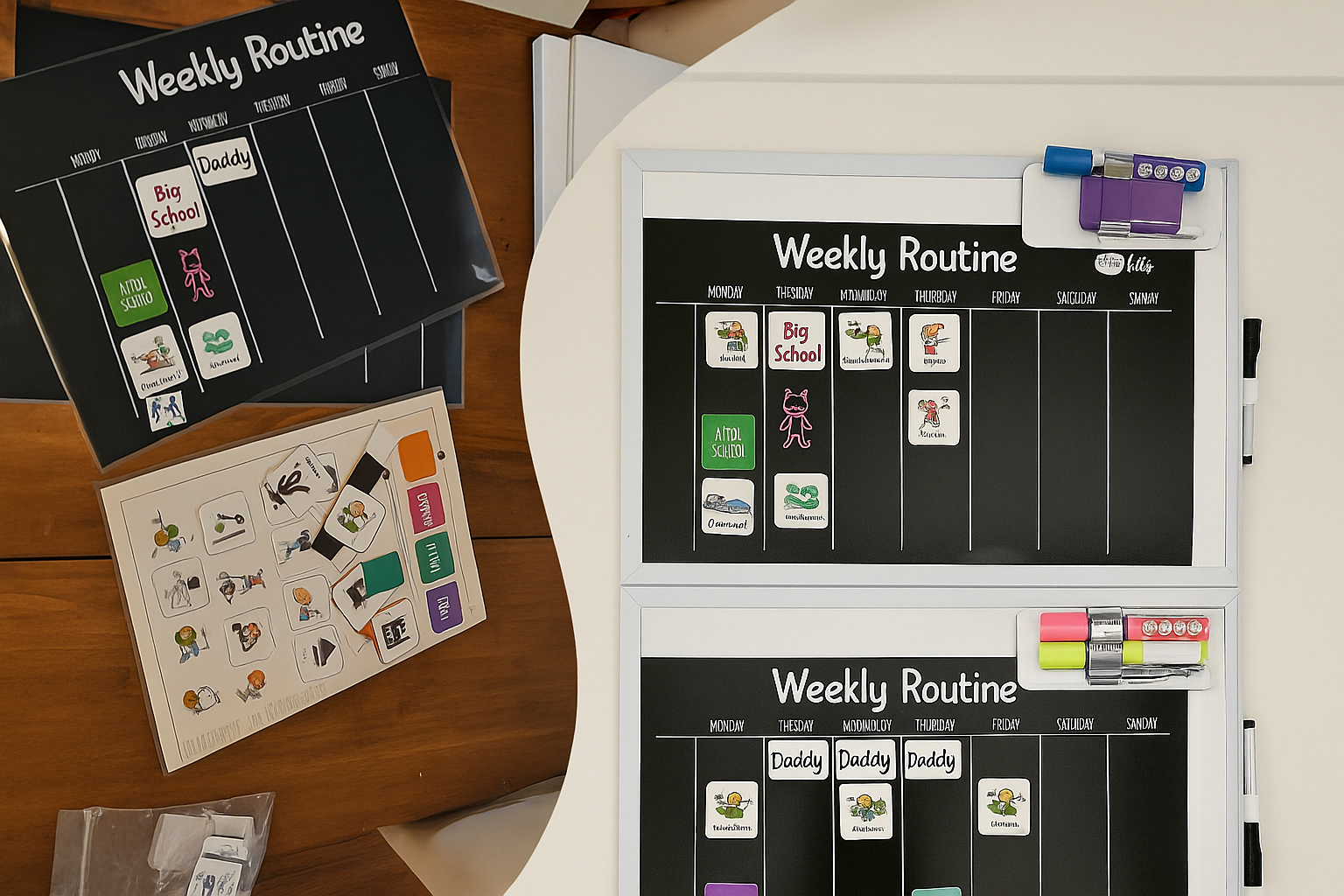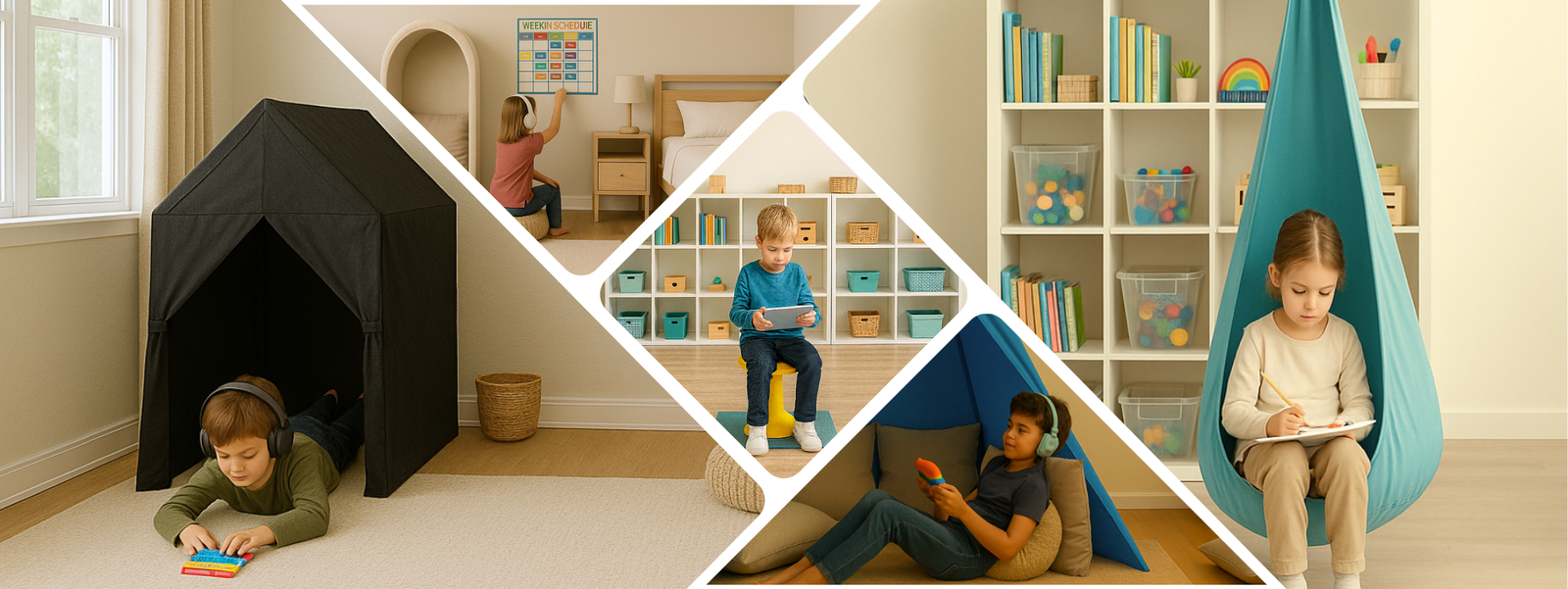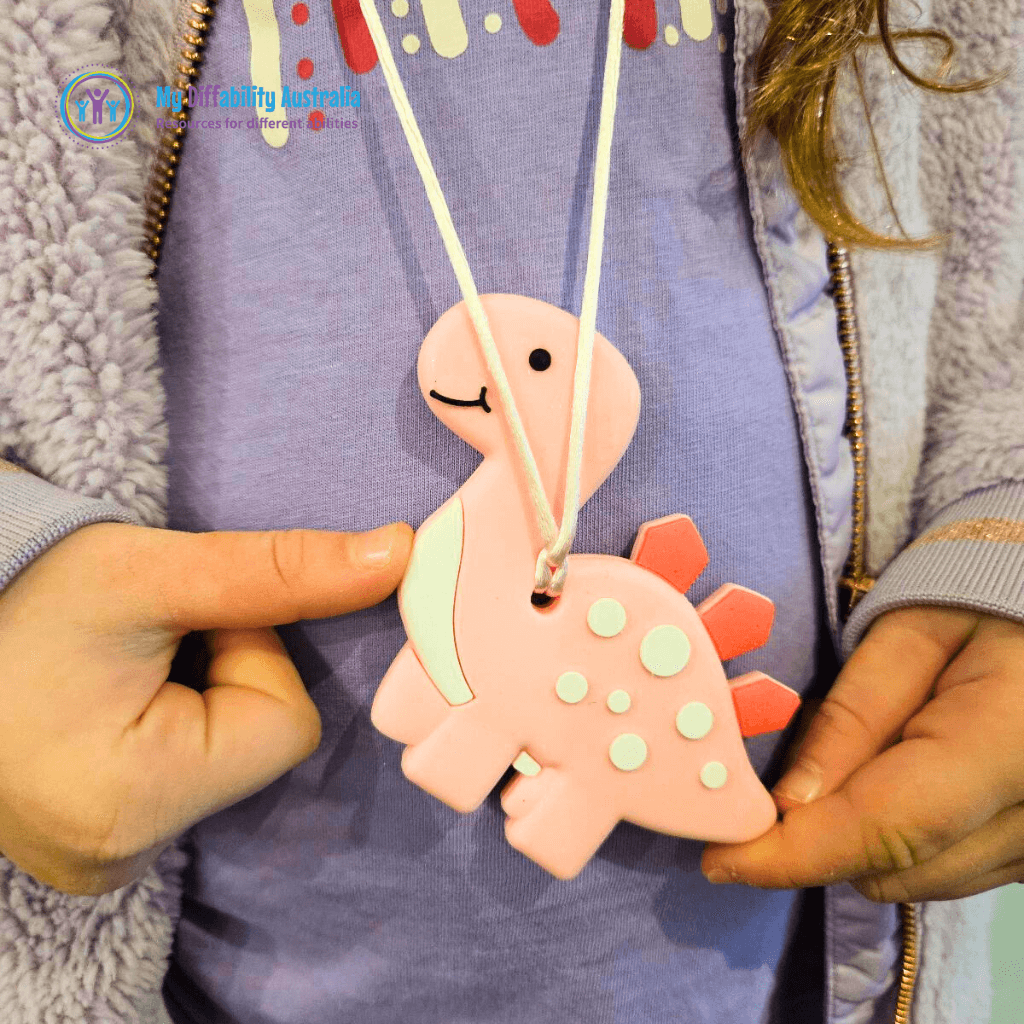When Life Changes, Visuals Can Help Kids Feel Safe
As a Paediatric Speech Pathologist and mum of three children five and under, I know just how big and overwhelming change can feel. And that's just for us adults! Change is especially for our little ones.
This week, our family had to adjust to a new routine; my children’s dad has taken a job 1.5 hours away, and now we will only see him every one or two weeks. My eldest is a particularly sensitive young soul and so I knew this change was going to be hard for her.
These kinds of transitions are a lot for young children to take in. They often don’t understand abstract concepts like time, or verbal explanations like “next weekend” or “in two weeks.” To support her and her younger siblings, (and myself!) I created an individualised fortnightly visual schedule using some of the same tools and strategies I’ve used for years as a paediatric speech pathologist.
I've worked extensively with children who experience anxiety, difficulty understanding routines, and those who are neurodivergent, including many autistic kids. Now, I’m using those same strategies in my own home, and it’s made a world of difference already.
If you enjoy watching videos more than reading, I recorded the process for you too!
Why Visual Schedules Help Kids Through Change
Children thrive on predictability. It helps them feel secure, regulated, and more in control of their world. When routines are disrupted by things small things like a parent travelling for a short time, school holidays, or toilet training it can really have a big impact for them. Then when it comes to big transitions like starting school, or moving house, children can feel this more and often experience uncertainty that they can’t always express in words.
A visual schedule gives them a clear, concrete representation of what’s happening and when. For younger kids who can't read yet, pictures are especially powerful. They can “see” their week ahead, know when dad is visiting, when kinder starts, or when a quiet day at home is coming.
For kids with additional needs or those who are neurodivergent, visual tools can be a lifeline. They reduce the cognitive load of holding plans in working memory, and they can support smoother transitions between activities and events.
What You’ll Need to Create a Fortnightly Visual Schedule
Back in the day when I started working as a Speechie, we used to make visual schedules from scratch. It was a tedious and time-consuming process, but the hours of drawing or using computer programs to make visuals, laminating, cutting, velcroing and more were worth it when we saw the benefits for the kids and families we were supporting.
These days thankfully there are so many commercially available schedules and visual supports that are real time-savers. They are more affordable and mainstream now, and there are also some great Australian-made resources available, so the visuals and vocabulary are relevant to our kids.
For my visual schedule, I chose to use two of our Weekly Routine Charts - Kinder editions. I chose these because they have the A3 weekly lay out clearly displayed on a magnetic board and come with a bunch of visuals suitable for pre-school aged kids. As my kids get older I'll probably move on to the School Edition of the Weekly Routine Chart.
Here’s a simple list of what I used in my home to set up a 14-day calendar that’s engaging and child-friendly:
1. 2 x Magnetic Visual Schedule Base (from the weekly routine charts; 1 in each set)
I used 2 x large A3, fridge-friendly magnetic boards. Because I have 3 kids 5 and under though, having anything with magnets on the fridge is a nightmare because they all get torn down within a few minutes! Because of this, I also purchased separately 2 x A3 magnetic whiteboards. That way, I was able to position them where they were still really visible and we can look at them throughout the day, but they won't be destroyed by the kids.
2. Daily Routine Magnets
These are the heart of the system. The Weekly Charts come with a range of really helpful visuals, including things like Kindergarten, Visit Grandparents, Swimming, etc. I wanted to further customise mine though, so I purchased some blank magnetic strips that I then cut up to make some of my own visuals for common, recurring activities (like Daddy coming home, or Grandad coming to stay).
3. A 14-Day Calendar Layout
Instead of just showing one week, I created a two-week view so the kids could “see” when Dad would be back again. This helps bridge longer time gaps, and it’s been so helpful for reducing repetitive questions like “When is Dad coming back?”
We mark today’s date with a bright circle, and move it along each morning.
My kids are quite familiar with using visual schedules and calendars, so we were able to start out with a fortnightly set up straight away. Some kids will benefit from starting with a weekly schedule and practising with that before moving on to something more complex. Later on, my kids will use a monthly schedule just like adults use calendars.
4. Optional Accessories
In addition to the ready-to-go packs and whiteboards, I also used some liquid chalk markers. These markers are really helpful for adding in quick details as you go, for highlighting days and special events, and for adding things to the calendar that aren't happening regularly (when you don't want to use up your magnetic strip for them).
I also purchased an eraser and some magnetic pockets to store all of my accessories to make it a bit more accessible and quick to use.
How We Use It In Our Home
Every Sunday, we will sit down together and set up the next week. I guide the kids through each day - what’s coming up, who they’ll see, and any special events. We name each day as we place the magnets. They love doing this because they are learning about the days of the week at kindergarten at the moment.
This ritual can become such a calming and important time for connection and centering. It empowers them with knowledge, and gives them a sense of ownership over their time. To be honest, I find it calming too because I am laying out the week myself in a simpler format than my intense phone calendar!
I’ve noticed they’re already asking fewer anxious questions, having fewer meltdowns about surprises, and feeling more secure, even though Dad is away more often.
Tips for Getting Started With Your Own Fortnightly Visual Schedule
- You don’t need to make it fancy or perfect. Start small and build on it.
- Involve your child in setting it up – this builds understanding and buy-in.
- Keep visuals consistent – use the same icon for “Dad day” each time.
- Use colour-coding to increase understanding if needed.
- Use it proactively – look at the schedule together each morning (we do this while we are having breakfast). They also like to take down the magnets as we move through the day.
- Respond gently to confusion – it’s OK to revisit and explain often.
- Be flexible – it’s a guide, not a contract.
- Even a simple setup can have a big impact.
- Meet your child where they are at. Start simple with a weekly schedule or maybe just one activity a day to begin with if that's where there level of understanding is. Build on it from there. Some kids may not need pictures; if your child can read you might like to skip this part and go straight to a written schedule.
When a Visual Schedule Can Be Most Helpful
Visual schedules are wonderful everyday tools, but they’re especially powerful during times of transition, including:
- Starting kindergarten, or school
- Separation from a parent (e.g. FIFO, travel, separation/divorce)
- Moving house
- New baby arriving
- Changes in carers or routine
- Holiday periods or school breaks
- Times of heightened anxiety or emotional dysregulation
- Learning a new skill like toilet training
If you’ve noticed your child is feeling unsettled or clingy, or is asking the same questions repeatedly, a visual schedule can help them feel grounded and reassured and help you keep your sanity!
Shop the Visual Schedule Tools We Use
The weekly routine charts we use in our home are available in our store. They’re designed with little hands and developing minds in mind. Simple, clear, and adaptable. Our collection also features a range of visuals to help with understanding routines like Before & After School or Morning & Evening routines. Browse Our Full Collection Here.
And Please Remember, You’re Doing a Great Job!!
Parenting through change is not easy, especially when you're holding your own emotions while supporting your child’s. A visual schedule doesn’t fix everything, but it’s a simple, powerful tool that can bring calm and connection into your everyday rhythm.
If you’re feeling unsure about where to start, we're here to help. As both a speech pathologist and OT, and fellow parents navigating change, we understand the ups and downs.
Feel free to reach out if you’d like help choosing the right tools for your family.
You’ve got this!





Leave a comment (all fields required)